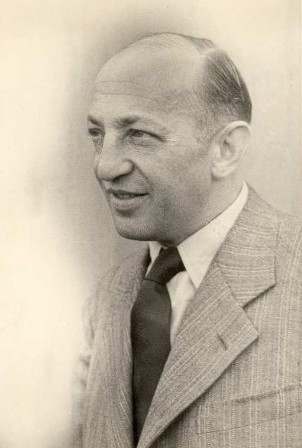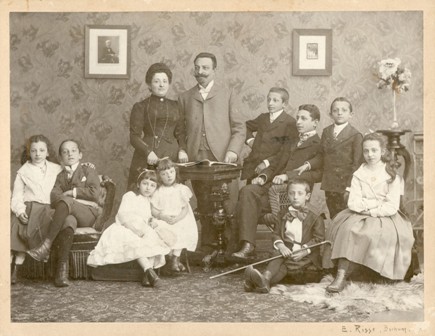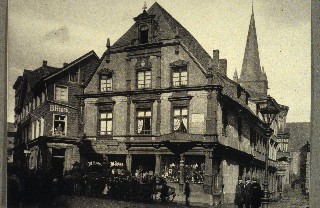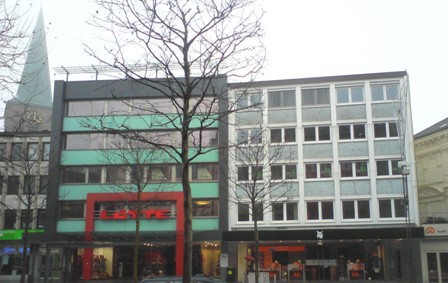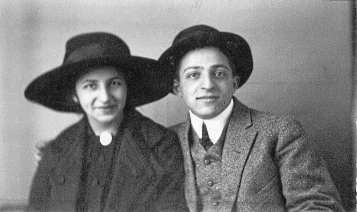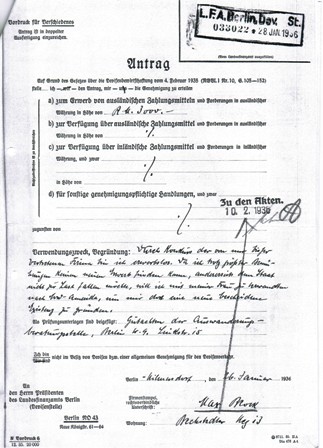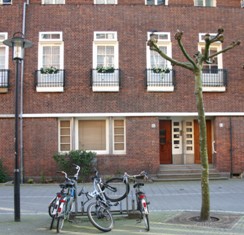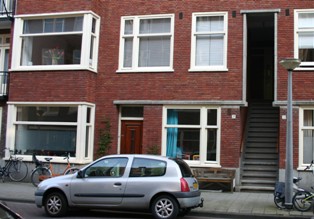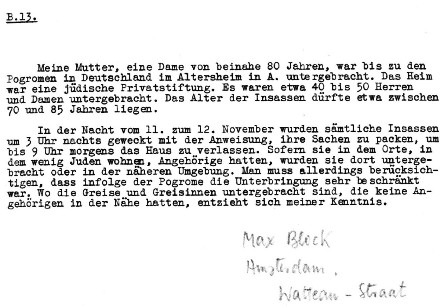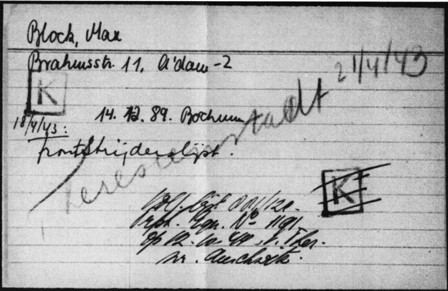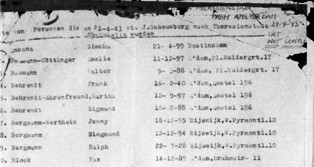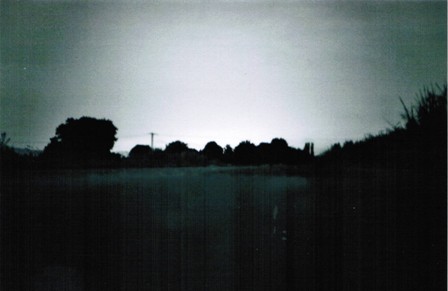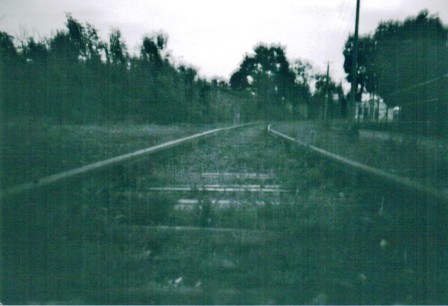Holocaust Education & Archive Research Team |
|
Survivor Stories
Holocaust Survivors Chelmno Survivors Righteous Gentiles Holocaust Recalled
| |||||||||||||||
The story of Max Block (Part 1)
(no grammatical corrections were made to the original text)
Bochum
Max Block was born in Bochum on December 14th, 1889. He is the fourth of Bendix and Therese Block’s (née Mayer) twelve children.
Bendix Block owns a men’s wear store in the city centre (Obere Marktstraße). Occasionally the children have to help. Max‘ sister Herta remembers:
“Max, who often had to help too, liked playing jokes in a way the customers did not understand, but we children were having fun about it. For example, when offering a colour shirt he said: “You can wash it LAU” (lukewarm). He winked at us, as if he wanted to say:
“You can NOT wash it”, using the Hebrew word “LAU” (not). In fact you could wash the shirt quite normally. He was just making fun.“1
Max successfully completes secondary school and becomes a merchant. After his father’s death, the family moves to Neustraße 18. Max Block is enlisted to fight in World War I.
Berlin Max moves to Berlin in 1917, where he works as a banker. On March 31st, 1930 he marries Gertrud Hildegard Rosenthal (born April 15th, 1905 in Berlin). They don’t have any children. From 1931-36 they live in Bechstedter Weg 13 in Berlin-Wilmersdorf 2. Max‘ niece Nora Walter, born in 1923, writes: „Max was my mother’s favorite brother and thus my favorite uncle. This was also because he could perform magic and spit through his tooth-gap! And something else impressed me deeply: In grandma’s glass cabinet there was a little Vaseline tin with a hole in its lid. Once Max showed me the tin and told me that it was in his pocket when he was a soldier. He was hit by a bullet which stuck to the Vaseline. ,If I didn’t have that tin with me, there would be no Uncle Max anymore’, he said with a serious expression.
– But usually Max was rather cheerful, [...] and very good-natured.” Max has a good relationship with his mother. Nora Walter remembers: „I know from my mother that grandma liked travelling and made up her mind quickly. When her son Max from Berlin was visiting and asked her at nighttime: ‘Mother, will you accompany me to Berlin tomorrow?’, she would breath shortly and ask back: ‘Tomorrow? What time?’ A few minutes later she would accept.” 3 Max‘ sister Nora Block (later Platiel) becomes a lawyer. As a left-wing activist in the „Internationaler Sozialistischen Kampfbund“ (ISK), she is forced to flee from Germany to France in 1933 directly after the Nazis’ takeover of power. In 1934, her sister Herta also emigrates with her family to Paris; her husband Berthold Walter tries to establish a business there without success and decides to return to Germany. In Hamburg, he seeks to earn his living as a peddler; he is treated so cruel and humiliated so badly that he commits suicide in August 1935. His daughter Nora Walter reports: "These days we received the sad news from an uncle, Max Block, who still lived in Germany. As the only relative in Germany he was told by the police that my father was dead and hurried to Hamburg instantly.” 4 Deeply traumatized by these events, Max also makes plans to emigrate. In January 26th, 1936, he writes to Berlin financial office in order to obtain foreign currency: “Due to bankruptcy of the company I was working for, I am unemployed.
As I am not able to find a new job despite my hard efforts, and on the other hand do not want to be a burden on the state, I want to go to relatives in North America together with my wife in order to pursue a modest living.” Two of his brothers, Oskar and Richard, emigrated to the United States long before the Nazis took power in Germany; his sister Hannah married the American lawyer Leo Gallagher, who had attended to the Reichstag fire trial as an international observer. The financial office answered promptly with a form stating: „To my regret I am unable to respond to your request dated...due to lack of foreign currency“. 5 Max‘ brother Erich fled to Amsterdam as early as September 1933, and emigrated to Argentina in November 1935 6; his experiences may have contributed to the fact that Max also chooses the Netherlands as his new flight destination. Amsterdam Thus Max emigrates to Amsterdam together with his wife. From August 12th, 1936 they are registered at Beethovenstraat 64. 7 This street is part of a new quarter in Southern Amsterdam, which is frequented by many Jewish refugees from Germany. A kind of German-Jewish colony is arising there, with its own cabarets and two publishing companies. 8 Numerous German Jews fled to the Netherlands in 1933 and the years to follow, among them many prominent members of political and cultural life. A considerable part emigrates further to safe countries; about 24,000 stay in the Netherlands for a longer period. Most of these emigrants are going to be trapped in the very place where they sought shelter. 9 Max Block und Gertrud Rosenthal move to Brahmsstraat 11 in May 10th, 1937, then to Watteaustraat 21 (1st floor) on November 3rd, 1938. According to the Gezinskaart (family record) he works as a waste paper dealer. 10
In November 1938, Max writes a report on the maltreatment of his 78 year old mother Therese Block during the Kristallnacht. Together with the other fifty inhabitants of a small Jewish old people’s home in Western Germany, she is rudely woken at 3 a.m. on November 12th, 1938, and told that she has to leave the home within six hours (shortly thereafter, she manages to emigrate to Los Angeles where two of her daughters live).
The report is submitted to the Wiener library, 11 founded by German Jew Alfred Wiener who fled to Amsterdam in 1933 and collected documents on Jews' persecution.
On March 31, 1939, Max Block moves back to Brahmsstraat 11. On July 11th, 1939, he gets divorced from Gertrud, who marries a Mr. Rummelsburg She then emigrates to England in 1940. 12 After Kristallnacht in November 1938, the number of refugees to the Netherlands increases again. From now on, the borders are guarded closely, the fugitives are sent back to Germany or to camps; the largest camp is Westerbork in the northeast of the country.7 In May 1940, the Netherlands are occupied by German troups, causing horror to many emigrants. Step by step, the repressive measures against the Jews in Germany are also imposed on the „Reichskommissariat“ of the Netherlands. At first, Jews are banned from coastal areas in order to block any getaway; then all Jews are dismissed from public service. In January 1941, all Jews have to register; a little time later there is a first big raid in Amsterdam with more than 400 arrested. Protests of the Dutch people, even including a general strike on February 25th, 1941, are violently suppressed. The arrested Jews are deported to a concentration camp, none of them returns. Jews are prohibited to visit libraries, parks, or cabarets, they are not allowed to use public transport or even a bicycle. Any shopping is restricted to 3-5 p.m. Jewish business gets confiscated („aryanized“), unemployed Jews are transferred to labor camps. In February 1942, all Jewish identity cards are stamped with a „J“. Two months later all Jews are forced to wear the yellow star with the inscription „Jood“. Mass deportations start shortly thereafter. About 3,000 Jews are able to cross the border illegaly; about 25,000 go into hiding, 10,000 of them get denounced or discovered. From July 1942, every week a freight train containing usually about 1,000 Jewish men, women and children rolls to the „work deployment in the east“, in fact to the extermination camps Auschwitz and Sobibor. Only 5,500 of the approximately 110,000 deportees from the Netherlands (more than three quarters of the Jewish population) will survive. 14,15 Because he was a soldier in World War I, Max is protected against this threat for some time: His name is on the „Frontkämpferliste“ (veteran’s list), thus he benefits from the „Sperre“ („barring“), saving him from being deported to the death camps immediately. 16
Theresienstadt Max Block gets deported nearly one year later on Transport XXIV/1, the first deportation from Amsterdam to Theresienstadt, leaving at 1.42 p.m. on April 21th, 1943. 295 men, woman and children are on the train; 100 of them are gathered directly at the Joodse Schouwburg in Amsterdam, while the others have been brought from Westerbork camp the day before they leave. 53 out of the 295 deportees will survive the war 17, among them Else Dormitzer, who writes this report after the war: „On April 20, 1943, a number of Jews ‚of outstanding merit‘ (mostly Germans, but also Dutch and Czech jews) were summoned to a SS quarter, where Eichmann‘s* representative for Holland, SS STBF aus der Fünten*, told them that the transport to Theresienstadt was a special privilege. Those who would decide not to take part in it could not expect any more protection. The conditions in the camp were described as ideal: complete freedom, rich food as provided for the SS people, cinema in town, lovely countryside etc. Aus der Fünten advised ‚the ladies to take good shoes with them for the excursions‘. The next day, they went in normal wagons, just four people in each compartment. During the 28-hour ride, the guards distributed post cards which were to be written to family members.“ 18 The train stops at Bauschowitz station; the deportees have to walk about three kilometers to Theresienstadt (the direct railway track to the Ghetto, built by the inmates, is not finished until May 1943). 19 The newcomers find out rapidly how much the reality differs from these promises. Resi Weglein, a Jewish nurse from Ulm who has to work in Theresienstadt from 1942-45, writes in her memoirs:
„It was awful when a transport had arrived. It took the newcomers weeks to get used to the small rations and the bad quality of food. Especially the Dutch were very appalled, because they had received much better food in their camp Westerbork.” 20 On November 11, 1943, the infamous „census“ is being held outdoors in the vast lowland between Theresienstadt and Bauschowitz. Almost all inmates have to line up between 5.30 and 9.30 a.m.; it is very likely that Max is among them.
Resi Weglein recounts:
"The procession of the 30,000 moves along the dull country road The march takes two hours, and after that the poor people had to stand still on one spot until 10 p.m. Nobody talked of census any more. [...] Many people fainted of course, mainly because they were too hungry and cold. It was forbidden to help them or even to move.
People also had to urinate on the very spot they were standing. It was an enormous turmoil, as many people lost their temper and cried and screamed. And there was no order to go back; on the contrary, news was spread that the ghetto was barred for these 30,000. The most courageous started their way back at 8 p.m., and by 10 p.m. the 30,000 arrived in the ghetto, nearly starved and frozen, in complete derangement.
Many tears had to be dried and many nerves to be soothed that night." 21
The chronicler of Theresienstadt, H.G. Adler, remarks laconically:
Thus ended the only excursion from the ‚ghetto’, for tens of thousands the only time they got out of the fort during the years of internment.“ 22 This discrepancy between promises and reality is typical for the Nazis’ cynical strategy. In November 1941 they transform the 18th century fortress of Terezin, situated to the north of Prague, into a transit and concentration camp for Jews and call it “Ghetto Theresienstadt”. Old Jewish Germans are forced to sign a “Home Purchase Contract” and to hand over all of their properties; many of them believe to obtain accommodation and care in an old people’s home, and get disappointed bitterly. In 1942, up to 53,000 mostly aged Jews are crammed into the town housing 7,000 people before the war.
Food is as scarce as the space for living; many deportees die within weeks from starvation, exhaustion, and epidemic diseases. And a vast number gets deported a second time, to the extermination camps in Poland. The horror caused by this threat must have been ubiquitous. Compared to this hell, the “Ghetto” appeared the lesser evil. There are still about 45,000 people living in very confined space23 when Max Block arrives in Theresienstadt. His brother-in-law, Heinrich Walter from Munich, is also imprisoned there from 1942-45, working as a male nurse. It is quite likely that the two meet and try to help each other as much as possible; there is no proof on this though. Likewise, I did not find any hints on Max’s specific living and working conditions. In general, men and women are accommodated separately, chiefly in barracks with halls (up to 400 inhabitants) and rooms (30-60 inmates), mostly furnished with three bunk beds. Average living space in Theresienstadt is 2,05 square meters in 1943. Due to deportation of 17,500 people, it rises to 3,05 square meters in June 1944. 24 Every healthy „ghetto“ inmate aged from 16 to 60 years of age is forced to labor; all newcomers have to start with often hard labor in „a hundred“, requests to change work are often ignored of delayed for months. 25 These hard conditions are attenuated a little by a rich cultural life on a high level, as many “prominents” from culture, sciences, and politics are among the „ghetto“ inmates. In 1943/44, lectures, concerts, cabaret and drama performances take place almost daily. There are premieres of many plays and compositions. 26 The survivor Federica Spitzer writes: „As ordered by the SS, „town beautification“ started in the end of 1943 under Commandant Burger*, a former clerk. He was not capable to achieve this job and therefore was replaced by Karl Rahm*, a mechanic from Vienna. [...] Why this beautification? Theresienstadt was to give the illusion of a friendlly holiday resort to the Red Cross commissions and others. [...] They created lawns, planted rose beds, and erected a bandstand as in the spas. Even a children’s playground was constructed.“27 This deception is successful during the visit of the International Red Cross delegation on June 23, 1944. In the following months there are no deportations. By order of the SS leader Günther* a movie is filmed titled „Theresienstadt. A documentary from the Jewish settlement area“ which the inmates called ironically „The Fuehrer donates a town to the Jews”. The Nazis force the Jewish actor and director Kurt Gerron to direct it. Like Max, Gerron fled from Berlin to Amsterdam and got deported to Theresienstadt; like Max he gets murdered in Auschwitz even before the movie is completed. 28 External factors in Summer 1944 may have influenced the measures inflicted by the Nazis to the Theresienstadt „ghetto“ in autumn: Allied forces land in Normandy in June. Frequent air raids gave hope to the inmates that liberation was near. On July 20, an attempt to assassinate Hitler fails. In August, uprisings first in Warsaw, then in Slovakia are both suppressed violently. The Nazis fear a revolt from Theresienstadt inmates also. This might have been the background for the eleven Theresienstadt autumn deportations from September, 28th, to October, 28th, 1944. Out of 18,402 deportees, only 1,574 survived.
On September 24th, 1944, in an evening roll call of all male inmates, Theresienstadt Jewish Elder Paul Eppstein announces that two „Arbeitseinsatztransporte“ (labour deployment transports) of 2,500 men each would be sent to the „Reich“ (to Germany). His message came across like lightning and was known to the whole ghetto within seconds“, Theresienstadt chronicler Willy Mahler writes in his diary. 29 Eppstein, who knows the real aim of the deportations, is taken to the „Little Fortress“ where he gets shot one day before the deportations begin. Only after the second transportation, the inmates are informed that deportations will continue. All men born from 1889-1928 are to prepare for transportation; also officers from World War I are included now. 30 Resi Weglein writes: „In October 1944, the intention was clear that the Nazis would exterminate as many prominent and intelligent people as possible. [...] None of us could feel secure, every single person reckoned to be on the next transport. Sadly, we could accompany our friends only up to the „Schleuse“ (floodgate) in the Hamburg barracks, we were not allowed to go in anymore.“ (“Schleuse” is the Theresienstadt term for spaces in various buildings where deportees of the arriving and departing transports were confined.) „„A considerable part of the luggage which all deportees had prepared for the transports was left behind in Theresienstadt. [...] Huge piles of this luggage were still in all barracks, and our hearts were in deep pain when we read the names of friends and acquaintances on the patches sewed on the pieces.“ 31 Both Resi Weglein and Max’ brother-in-law were not selected for transportation, be it for their relatively high age, be it because they were „indispensable“ as nurses.
From 1942-45, more than 141,000 Jews are interned in Theresienstadt (more 75,000 from Czechoslovakia, nearly 42,000 from Germany, more than 15,000 from Austria, nearly 5,000 from the Netherlands). With 63 transports, more than 88,000 get deported „to the East“; one of them is Max.
Only 3,600 of these unfortunates survive. Of those remaining in the „ghetto“, about 68,000 people, 33,500 die mostly due to systematic malnutrition, but also to disease and maltreatment.
Sources: (see part 2)
Copyright. Thomas Nowotny H.E.A.R.T 2012
|
